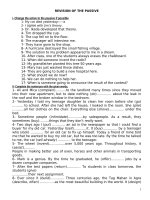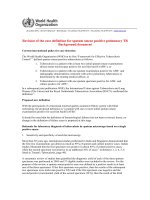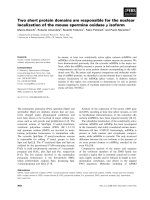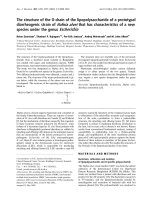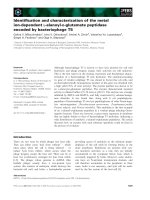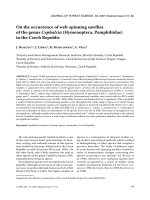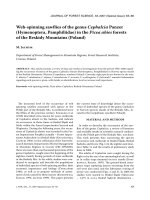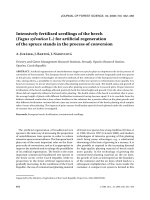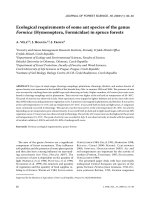Revision of Indian Crab Spiders (Aranee : Thomisidae)
Bạn đang xem bản rút gọn của tài liệu. Xem và tải ngay bản đầy đủ của tài liệu tại đây (4.43 MB, 94 trang )
ZSJ. xv. 3
568 .
MEMOIRS
OF THE
,Z O 'O L'O GICAL SURVEY OF IND A
Vol. XV, No,. 3
Pages
Revision of Indian Crab Spiders (Arane&e : Thomisidae)
By B ,. K. 'T ikader ...
1-90
Edited by tke D ,irector, Zoological Survey of India
(C)
Copyr;g ht 1911,
Gov~rnment
0,1 India
PlUNTED IN INDIA BY MIs EKA PRESS, 204/1 BARRACKPORE TRUNKIlOAD, CALCU'rrA~ :i6
AND PUBLISHED BY THE MANAGER OF PUBLlCATIQ S,CML LINES, DELHI, lun
PUBLISHED
July, 1911
REVISION OF INDIAN CRAB SPIDERS (ARANEAE: THOMISIDAE)
By
.B. K.
Tm:.AnER,
D.Phil., D.Se.
Superintending Zoologist, ZoologicaZ Survey of India, 34, Ohittaranjan Avenue, Oalcutta
( With 22 Text-figures)
CONTENTS
Page
I-INTRODUCTION
5
5
II-AcKNOWLEDGEMENTS
6
Ill-MoRPHOLOGY
IV-SYSTEMATIC ACCOUNT
12
FAMILY THOMISIDAE
12
Subfamily MISUMENINAE
12
KEY TO THE GENERA OF THE SUBFAMILY
Genus I.
Thomisus Walckenaer
KEY TO SPECIES OF THE GENUS
l.
2.
3.
4.
5.
6.
7.
8.
9.
10.
11.
12.
13.
14.
15.
16.
ThomisU8 Walckenaer
Tlwmisus sikkimensis Tikader
T. shivajiensis Tikader
T. pooneus Tikader
T. loboSU8 Tikader
T. katrajghatus "Tikader
T. projectus Tikader .
T. dhakuriensis Tikader
T. memae Sen and Basu
T. rishus Tikader
T. sorajaii Basu
T. pugilis Stoliczka
T. bulani Tikader
T. shillongensis Sen
T. beautifularis Basu
T. cherapunjeus Tikader
T. elongatus Stoliczka
Genus II. Runcinia Simon
17.
MIBUMENINAE
Runcinia roonwali Tikader
12
13
14
14
16
16
17
17
18
18
20
20
21
21
22
22
24
24
25
26
26
18. R. escheri Reimoser
26
Genus III. Pistius Simon
28
Page
KEY TO SPECIES OF THE GENUS
19.
20.
2l.
22.
23.
24.
25.
26.
Pistius Simon
28
Pistius bhadurii Basu
P. gangulyi Basu
P. robusta Basu
P. sreepanchamii Tikader
P. kanikae Basu
P. kalimpus Tikader
P. barchensis Basu
P. roonwali Basu
29
29
• 30
30
32
32
• 33
33
Genus IV. Oxyptila Simon
KEy
TO SPECIES OF THE GENUS
35
Oxyptila Simon
35
27. Oxyptila khasi Tikader
28. O. maratha Tikader
29. O. manii Tikader
30. O. reenae Basu
35
36
36
• 37
Genus V. Misum:ena Latreille
KEY TO SPECIES OF THE GENUS
37
Misumena Latreille
Misumena menoka Tikader
M. indra Tikader
M. horai Tikader
M. mridulai Tikader
M. silveryi Tikader
M. annapurna Tikader
37. M. greenae Tikader
31.
32.
33.
34.
35.
36.
38
40
40
42
42
42
43
Genus VI. Diaea Thorell
38.
43
Diaea jaintious Tikader
44
Xysticus Koch.
44-
Genus VII.
KEy
38
TO SPECIES OF THE GENUS
Xysticus Koch
39. Xysticus kamakhyai Tikader
40. X. hindusthanicus Basu
4l. X. roonwali Tikader
42. X. shyamrupus Tikader •
43. X. sikkimus Tikader
44. X. kashidi Tikader
45. X. mandali Tikader
46. X. minutus Tikader
47. X. sujatai Tikader
48. X. pynurus Tikader
49. X. jayantius Tikader
50. X. shillongensis Tikader
454546
46
•
•
47
47
49
• 4950
50
52
52.
53
Genus VIII. Synae:ma Simon
53
51. Synaema decorata Tikader
52. S. brunettii Tikader
5454-
2
Page
Genus IX.
Bomis Koch
53. Bomis bengalensis Tikader
54
55
Genus X. Monaeses Thorell
54. M onaeses parvati Tikader
57
Genus XI. Tmarus Simon
55. Tmarus kotigeharus Tikader
57
57
Genus XII. Misumenoides Cambridge
58
THE GENUS Misumenoides Cambridge
M isumenoides kripalaniae Tikader
M. deccanes Tikader
M. shulli Tikader
KEY TO SPECIES
56.
57.
58.
55
OF
58
58
59
59
Genus XIII. Misumenops Cambridge
59. M isumenops khandalaensis Tikader
60
60
Genus XIV. Pasias Simon
61
60. Pasias puspagiri Tikader
61. P. marathas Tikader
61
61
Genus XV. Strigoplus Simon
62. Strigoplus netravati Tikader
63
63
Genus XVI.
Regillus Cambridge
63. RegUlus elephantus Tikader
64
64
Genus XVII. Amyciaea Simon
64. Amyciaea forticeps (Cambridge)
64
Genus XVIII.
65
65
Subfamilr PHILODROMINAE
66
65
Platythomisus Dolesch.
65. Platythomisus bazarus Tikader
KEY TO THE GENERA
OF
THE SUBFAMILY PHILODROMINAE
Ebo Keyserling
66. Ebo bharatae Tikader
66
Genus XIX.
66
67
Genus XX. Philodromus Walckenaer
67
KEY TO SPECIES OF THE GENUS Philodromus Walckenaer
69
69
67. Philodromus domesticus Tikader
68. P. assamensis Tikader
69. P. betrabatai Tikader
70. P. shillongensis Tikader
71. P. kendrabatai Tikader
72. P. devhutai Tikader
73. P. manikae sp. n.
74. P. decoratus Tikader
75. P. mohiniae Tikader
76. P. bhagirathai Tikader
77. P. maliniae Tikader.
70
70
71
72
74
75
75
76
77
77
3
Pa.ge
Genus XXI.
78
Tibellus Simon
80
Tibellus Simon
KEY TO SPEOIES OF THE GENUS
80
80
81
82,
78. Tibellus chaturshingi Tikader
79. T. poonaensis Tikader
80. T. katrajghatus Tikader
81. T. elongatus Tikader
82
Genus XXII. ThanatDs Koch
KEY TO SPEOIES OF THE GENUS
82.
83.
84.
Thanatus Koch.
82
,.
83
Thanatus lanceolatus Tikader
T. dhakuricus Tikader
T. manaali Tikader
• 84
84
86
86
Genus XXIII. Apollophanes Cambridge
85.
Apollophanes bangalores Tikader
V-REFERENOES
• 87
4
I-INTRODUCTION
The Crab-spiders comprise the moderately large family Thomisidae, which is worl~
wide in distribution. The common name "crab-spiders" applied to the family refers
to the crab·like appearance of the majority of species. The body is short, broad and
the legs sprawl at right angles to the longitudinal axis. Most species are found on
vegetation but some occur on dead bark, on the ground, or in leaf detritus. Capture of
prey is effected without the means of a web but by ambush or less usually, by active
persuit. Gertsch (1939) has reviewed the somewhat limited information on the biology
of the family. The Indian Thomisidae have received little attention in the past.
Although thomisid spiders are abundant throughout the country, our knowledge
of the Indian Thomisidae is extremely fragmentary. One of the earliest contributions
on Indian crab-spiders was by Stoliczka (1869). Pocock (1900) recorded hardly two
hundred species of spiders from India, Burma and Ceylon. Many common and well
kn~wn forms like fThomisidae are not reported as occurring in India.
The relationship and numerical importance of the Oriental Thomisidae can best
be appreciated by comparison with other faunal areas. Arachnologists are fortunate
in having two major bibliographic works concerned with the world spider fauna. One
of these is Roewer's "Katalog der.Araneae" in which are listed in essential completeness
the spider representations from the entire world. An even more ambitious and scholarly
work is the "Bibliographia Araneaorum" of Pierre Bonnet of the University of Toulouse,
France which is now available. From these sources and from supplementary catalogues it
has been possible to glean reasonably accurate information on the distribution of thomisid
genera and species of the world. Such a list is no better than the systematics on which
it is based, so the following generalizations are subject to future revision. Altogether
eighty five species, contained in twenty three genera of the family Thomisidae, are
dealt ·with in this paper. I have given the general shape of cephalothorax and eye
position of each genus (text figures 4-5).
The figures, which illustrate this paper, were all prepared by myself with the helpof a camera lucida.
All types are deposited in the National Zoological Collections, Zoological Survey
of India, Calcutta. The other materials studied were deposited in the collection of
Eastern Regional Station, Zoological Survey of India, Shillong, Assam and Western
Regional Station, Zoological Survey of India, Poona, Maharashtra.
II-ACKNOWLEDGEMENTS
A revisional study cannot be brought to completion without help of many kinds
from' numerous individuals and institutions. I take this opportunity to express my
gratitude for loans and gifts of specimens and other helps to : .
Dr. W. J. Gertsch, Curator, American Museum of Natural History, New York;
Dr. J. A. L. Cooke, Department of Zoology, Oxford University, Oxford; Dr. Fr. Chry.
santhus, O.F.M. Oosterhout (N.B.), Netherlands; Dr. Charles D. Dondale, Department
of Agriculture, Canada; Shri B. S. Lamba, Superintending Zoologist, Zoological Survey
of India, Western Regional Station, Poona; Dr. A. S. Rao, Regional Botanist, Botanical
Survey of India, Eastern Circle, Shillong, Assam; Shri J. K. Sen, Assistant Zoologist,
Arachnida Section and Dr. A. K. MandaI, Assistant Zoologist, Zoological Survey of
India, Calcutta.
I record my sincere thanks to _Dr. A. P. Kapur, Director, Zoological Survey of
India, Calcutta, for placing the valuable types~ named and unnamed thonlisid spider
2
Memoirs of the Zoological Survey of India
6
collections, Zoological Survey of India, Calcutta, at my disposal. My deepest appreciation for invaluable aid and constant encouragement in the present study goes especially
to Dr. M. S. Mani, Deputy Director and Dr. Biswamoy Biswas, Superintending Zoologist,
Zoological Survey of India, Calcutta.
.The following gentlemen were kind enough to collect crab spiders for me: Shri
Shyamrup Biswas, Shri Shyamal Chanda, Shri Bidyut Kumar Halder and Dr. E. M.
Shull.
I am indebted to Shri Mrinal Kanti Sen, Photographer of Eastern Regional Station,
Shillong for preparation of plates and to Shri Dil Bahadur Rana for the typing of this
manuscript.
III-MORPHOLOGY
Some of the cuticular morphological features of the Thomisidae, pertinent to
the present study, are summarized below. The terminology used is topological, and
homologies with other groups of arthropods have not. been clearly established. Some
new terminology was proposed by Schick (1965). For fuller reference to the terminologies of the male and female genitalia, references may be made to the excellent works of
Comstock (1910) and Gering (1953).
The body of spider is divisible into cephalothorax and abdomen, jointed together
by a narrow pedicel.
Oephalothorax
(Text-fig. 1, A-B)
The cephalothorax can be divided into three regions, the clypeus, the disc, and
bilateral allata. The clypeus is the area that lies between the cephalic margin of the
cephalothorax and the anterior median eyes, terminating laterally near the level of the
posterior lateral eyes.
---posterior declivity
A
TEXT-FIG.
A.
B.
1
Cephalothorax of Philodromus, dorsal view, showing different parts.
Cephalothorax of Xysticus, dorsal view, shoWing different parts.
The disc is a broad and elongated median region that' extends from the levels· of the
anterior median eyes to thoracic suture or fovea. The disc can be subdivided into:
(1) Prodiscus, the anterior portion lying in the ocular area, (2) Mesodiscus, the inter~
mediate and the longest portion delineated cephalad by the posterior median eyes, caudad
by the metadiscus and laterad by the cervical groove or, when the groove is not developed by a narrow stripe through setae or by difference in coloration of the allatum,
TIKADER :
Revision of Indian Grab Spiders
7
and (3) Metadiscus, the posterior portion developed as a usually distinct and white Vshaped marking.
The allatum is lateral and caudal to the discus and it may be unpigmented, uniformly pigmented, mottled or have a lateral or mesial pigmented stripe.
Eyes
Oriental Thomisidae have eight eyes, arJ,'anged in two transverse rows of four eyes
each, an anterior row and a posterior row. The eyes are notate in pairs: anterior
median eyes (AME), anterior lateral eyes (ALE), posterior median eyes (PME) and
posterior la.tera.l eyes (PLE). When the lateral eyes of a row are situated caudal to the
level of the median eyes that row is termed "recurved", and when the lateral eyes are
situated cephalic to the level of the median eyes, that row is termed "procurved".
Male Genitalia
(Text-fig. 2, A-B)
The'male genitalia in spiders are usually used in reference to the palpus, which is
the intromittent organ. The primary reproductive opening, the gonopore, is situated
in the epigastric furrow. The mature male spider spins a small sheet of web, upon
which it deposits a drop of semen, passed out through the gonopore. The genital bulb,
contained in the distal end of the palpus, is a complexly developed but essentially
hollow, bulb like structure. It is placed in contact with the semen, and the fluid passes
into the hollow internal part (the receptaculum seminis) to be stored until copulation.
At the time of copulation the tip of the genital bulb is inserted into the female genital
, orifice and the semen is ejected.
The palpus consists of seven segments (coxa, trochanter, femur, patella, tibia,
tarsus and pretarsus), but only the three terminal segments (also rarely the fou~th, the
patella) are modified to take part in copulation. There is a progressive increase in
specialization distally in these three or four segments, the pretarsus being the most
specialized.
The cymbi'llm is the tarsal segment of the palpus specialized for the reception of
the genital bulb. There are several structural modifications of the cymbium for this
purpose. The alveolus is a ventral depression, which receives the basal and middle
·divisions of the genita.l bulb. Although usually described as a cup like depression,
the alveolus is actually a ringed depression to the inner margin of which is joined the
basal hematcidocha (the membranous basal portion of the genital bulb).
The tutaculum
functionally supplants the conductor and is present only in the Thomisidae. Generally
it is formed as a shallow, membranous, tutacular groove developed peripherally along
the distal and usually on the retrolateral margins of the alveolus.
The genital bulb is the terminal segment of the palpus. It is a hollow organ, with
external elaborations. The genital bulb is divided by three divisions (1) Basal division,
(2) Middle division, (3) Apical division (after Comstock 1910).
BASAL DIVISION: The basal hematodocha is sclerotized basally to fornl a
somewhat triangular sclerite, the petiole, the base of which articulates or is partially
fused with the inner margin of the alveolus. The subtegulum is a comma-shaped sclerite
of which the bulbous apical end articulates with the tegulum.
MIDDLE DIVISION: The tegulum, a discoidal sclerite, is the main portion of
the middle division. The tegulum may bear apophyses, a conductor or other structures.
APICAL DIVISION: The conductor and the embolic subdivision conlprise the
apical division of the bulb (Comstock 1910). The conductor, a distal membranous or
Memoir8 of the Zoological Survey of India
8
sclerotized outgrowth of the tegulum which accommodates the apical portion of the
embolus. The embolic subdivision consists of the embolus in the Thomisidae. The
embolus is the actual intromittent part of the genital bulb.
apica'
alveolus
empolus",,- __
.condu~tor
-- ---.--d istal
paraembol~r ~'
apophYSIS -- -
-- ---te g u I.u m
basa',"-;
subtegulum'
receptaculum semini.
/
_____ --__ -proxi mal
tegu lar suture'
---------,RT A
A
_____________ cymbiu m
tegulum
\
.. -----truncus~ em b0 Ius
---~ pendula
\
receptaculum ...
seminis \ __ _
tatacular \- ---apophysis---tooth of
basal tegular ridge,
-- ---- MBA
-----A8A
RT A'"
VTA/
,-
RTA'
---------- --t ·b"
I Ia
B
TEXT-FIG.
A.
B.
2
Male palpi of Philodromus a8samensis Tikader, showing different parts.
Male palpi of Xysticus su}atai Tikader, showing different parts.
Female Genitalia
(Text-fig. 3, A-B)
The term female genitalia refers to both an external epigynum and a pair of longitudinal internal canals which are invaginations of the epigynal integument.. The
epigynum is a poorly to well-defined, media.n, sclerotized area developed about the intromittent orifices on the venter of the abdomen cephalad of the epigastric fUITow and
may bear structures of which some, at least, serve to orientate the male palpus during
copulation. Each internal canal is divided into an anterior receptaculum and a posterior
TIKADER
Revision of Indian Crab Spiders
9
.... --- ---)-- --intromittent orifice
- --- .:------- --------central division
,
.
I suture
•• - 'j----·_-· .. ---eplgyna
.
------Iateral guide pocket
8
A
A.
B.
TEXT-FIG. 3
Epigyne of Philodromus a8samensis Tikader, showing different parts.
Epigyne of Bomis bengalensis Tikader, showing different parts.
A
F
o
" I): •.~
H
I
i)\,c;l
t
l
j
a \
\ \
M
A.
B.
Cephalothorax of ThomisU8 Walckenaer
Cephalothorax of Xysticus Koch
Cephalothorax of Diaea Thorell
Cephalothorax of RegUlus Cambridge
Cephalothorax of M isumenops Cambridge
Cephalothorax of M isumenoides Cambridge
·0.
D.
E.
F.
3
G.
H.
J.
K.
L.
M.
\ \
I
\
\ \
Cephalothorax .of Pistius Simon
Cephalothorax of Bomis Koch
Cephalothorax of Apollophanu Cambridge
Cephalothorax of Amyciaea Simon
Cephalo~horax of Synaema Simon
Cephalothorax of TmarWl Simon
10
Memoirs of the Zoological Survey of India
fertilization tube. The anterior end of the internal epigynum opens into the epigynum
as the intromittent orifice and the posterior end ,into the vagina (Comstock 1910).
B
c
A
E
\
\
o
F
J
TEXT-FIG.
A.
B.
C.
D.
E.
F.
G.
H.
J.
K.
5
Cephalothorax of Oxyptila Simon
Cephalothorax of Tkanatus Koch
Cephalothorax of Tibellus Simon
Cephalothora;. 9f ~"'ilodr.omus Walckenaer
Cephalothorax of Strigoplus Simon
Cephalothorax of Ebo Keyserling
Cephalothorax of Runcinia Simon
Cephalotborax of Platythomisus Dolesch.
Cephalothorax of M onaeses T~orell
Cephalothorax o~ Pasias Simon
TlKADER :
Revision of Indian Crab Spiders
11
EPIGYNUM: Several types of structures, perhaps, serve as guides for the male
palpus. The guide pocket is a concavity overlain by a sclerotized plate, the hood; the
guide pocket may be antemedial on the epigynum and unpaired or bilaterally paired.
The median septum, if any, is a raised mediolongitudinal structure; cephalad the rim of
the septum may curve laterad, forming the arch of the median septum. In some cases
a basin-like depression, the atrium, is formed in the epigynum, and the surrounding rim
may serve as a palpal guide. Often the median septum divide~ the epigynum into
bilateral atria.
The receptaculum is usu,ally subdivided transversely into a morphologically, anterior
intromittent division and a posterior spermathe'ca. 'These are, functional subdivisions
and may not be homologous in the different groups. In relation to the designation of
directions along the axis of the receptaculum the term "proximal" refers to a direction
towards the intromittent orifire, and the "term '(distal''' to the direction towards the
fertilization cana1 orifice.
IV-SYSTEMATIC ACCOUNT
FAMILY THOMISIDAE
1833.
1869.
1892.
1935.
1940.
1951.
1960.
1962.
Thomisides:
Thomisidae:
Thomisidae:
Thomisidae:
Tkomisidae:
Thomisidae:
Thomisidae:
Thomisidae:
Sundevall, Conspectus arachnidum London, p. 27.
Stoliczka, J. Asiat. Soc. Bengal., 38, p. 225.
Simon, Histoire Nat. Araignees Paris, 1, p. 949.
Dyal, Bull. Zooz. Punjab Univ., 1, p. 209.
Comstock, The Spider Book, New York, p. 534.
Locket and Millidge, British Spider, London, 1, p. 168.
Tikader, J. Bombay nat. Hist. Soc., 57, p. 180.
Tikader, J. Linn. Soc., London, 44, p. 569.
Originally the family Thomisidae was a part of the family Bradystichidae. Sundevall (1833) pointed out that thomisid spider, have a peculiarly crab-like appearance
and he separated them under the family Thomisidae (Simon, 1892).
Thomisidae from India can be distinguished from other families by the following
characters :-The typical members have a peculiar crab-like appearance. Cephalothorax and abdomen are usually short and broad; but somewhat elongated in Tibellu8
and Thanatu8. The homogeneously coloured eyes (however, in life the anterior median
eyes appear lighter than the others), the free rather\than fused chelicerae, the lower
margin of which is indistinct and unarmed; the bearing of two toothed tarsal claws on
each laterigrade leg, one pair of book lungs; a single median tracheal opening near the
spinnerets, and the absence of cribellum and calamistrum characterize the fainily. First
two pair of legs are long and stout and frequently mbre sideways as is done by a crab;
the legs are less obvio~sly laterigrade in the genera Philodromu8 and Thanatu8, and
not at all in Tibellu8. The members of the genus Oxyptila have the integument furnished with some characteristic clavate setae, but in the other genera the hairs and
spines are normal.
The spiders of this family do not build snares, but in general catch their prey by
lying in wait or hunting for it. They live at ~ground level or in low vegetation.
Two subfamilies of the Thomisidae are known so far from India viz., MIS U MENINAE
and PHILODROMINAE.
Subfamily MISUMENINAE (Mi-su-me-ni'-nae)
In this subfamily the tarsi of the first and second pairs of legs are not furnished
with scopulae in either sex. I and II legs much longer than III and IV; the hairs of
the body are filiform or rod-shaped and erect; and the upper margin of the furrow of
the chelicerae is without tooth.
This subfamily includes the majority of our species of crab-spiders.
occurring in the Indian subcontinent· can be separated as follows : KEY TO THE GENERA OF THE SUBFAMILY
MISUMENINAE
1. Lateral eyes on strong conical protuberence
Lateral eyes not on conical protuberence
2.
Abdom~n
widened and truncated behind
Abdomen long, lateral sides with longitudinal muscular corrugation
The genera
rrIKADER :
Revision of Indian Grab Spiders
3.
Abdomen broadened and truncated behind
Abdomen broadened but not truncated behind
4.
Integument clothed with some clavate setae
Integument not clothed with clavate setae
Anterior eyes nearly equidistant
Anterior eyes not equidistant
5.
PistiUB
4
Oxyptila
5
Misumena
6
Body covered with conspicuous spines
Body not covered with conspicuous spines
6.
13
Diaea
7
Anterior median eyes close to the lateral eyes than to each other.
Anterior median eyes not close to lateral eyes
Xysticus
8.
Tarsal claws of I leg with 6-12 teeth
Tarsal claws of I leg without teeth
Synaema
9
9.
Cephalothorax wider than long
Cephalothorax longer than wide
7.
Bomis
10
10. Abdomen produced well beyond the spinners
Abdomen not produced beyond the spinners
11. Abdomen hIgh, with caudal tubercle
Abdomen not high
Monaeses
11
Tmarus
12
12. QlyPeus with a distinct, white transverse carin~ and carapace flat
Clypeus without white -transverse carina
13.
8
Anterior lateral eyes larger than the median eye
Anterior lateral eyes not larger than the medlan eye
14. Legs clothed with conspicuous spines
Legs not clothed with conspicuous spines
15. Margin of clypeus with one row of small clavate hairs
Margin of clypeus without clavate hairs
16. First pair of legs conspicuously robust
First pair of legs not conspicuously robust
17. Ant like spider
Not ant like spider
M isumenoides
·13
Misumenops
14
Pasias
15
Strigoplus
16
Regillus
17
Amyciaea
18
18. Abdomen without spines and tibiae and metatarsi I and II provided with conspicuous
Platythomisus
ventral spines
Genus I.
1805.
1869.
1870.
1892.
1935.
1962.
1965.
Thomisus Walckenaer
Thomisus Walckenaer, Tabl. Aron., p. 28.
Thomisus: Stoliczka, J. Asiat. Soc. Bengal, 38, p. 225.
Thomisus ~ Th~rell, 'On European Spiders, p. 170.
Thomisus: Simon, Hist. Nat. Araign., Paris, 1, p. 1023.
Thomisus: Dyal, Bull. Dept. Zool. Punjab Univ., 1, p. 200.
Thomisus: Tikader, J. Linn. Soc., London, 44 (300), p. 569.
Thomisus: Tikader, Proc. Indian A cad. Sci., Bangalore, 61(5), p. 283.
Ohal acters: Cephalothorax truncated in front, with the upper fore-corners strongly
ltnd conically protuberant and divergent, bearing the lateral eyes. Eyes very small.
Abdomen narrow and truncated in front, enlarging to a considerable width behind,
4
Memoirs of the Zoological Survey of India
14
where at either corner of the dorsal side is a short blunt conical protuberance.
long, I and II much longer than III and IV Typical crab-like appearance.
Type-Species: Thomisus albus Gmelin.
Distribution: Europe, Africa, Asia, Australia and America.
KEY TO THE SPECIES OF THE GENUS
Legs
Thomisus Walckenaer
1. Abdomen wider than long.
Abdomen longer than wide
15
2. First pair of legs with conspicuous black spots
First pair of legs without black spots
3
11
2
3. Cephalothorax with black patches
Cephalothorax without black patches
4
7
4. Abdomen with a transverse black band
Abdomen without transverse black band
T. sikkirnensi8
5
o.
T. shivajiensi8
6
Abdomen rectangular
Abdomen nearly round
6. Abdomen basally with a triangular deep brown marking
Abdomen on antero-lateral with some black spots
T.pooneus
T.lobo8'U8
T. kat1'ajghatus
7. Abdomen basally with a triangular black marking
Abdomen wtihout triangular black marking
8
8. :Broadest portion of abdomen tuberculated laterally and black spots on the tubercle
:Broadest portion of abdomen without tubercle
T. dhakuriensi8
10
9. Abdomen with paired elliptical black spots
Abdomen without black spots
10. Abdomen with three paired irregularly shaped black patches
Abdomen with transverse muscular corrugation posteriorly
T. rnemae
T. rishus
T.8orajaii
12
11. Abdomen with a transverse black band
Abdomen without transverse black band
12. Abdomen with a pair of shoulder tubercle~, each
in the middle
Abdomen without shoulder tubercle
T. projectus
9
wi~h
a black spot situated inwardly
13. Abdomen with three pairs 'of longitudinally arranged reddish brown spots
Abdomen without longitudinal spots
T.pugili8
13
T. bulani
14
14. :Broadest end of abdomen with a transverse black mark
Broadest end of abdomen without transverse mark
T. skillongensi8
T. bea,utifulari8
15. Cephalothorax with lateral longitudinal deep brown bands
Cephalothorax without lateral longitudinal band
T. ckerapunjeus
T. elongatus
1.
Thomisus sikkimensis Tikader
(Text-fig. 6, A-C)
1962. Thomisu8 sikkimensis Tikader, J. Linn. Soc., London, 44(300), p. 569.
General.' Cephalothorax and legs brownish-green, ocular area yellowish-brown~
with small chalk-white patches. Abdomen chalk-white. Total lengths 9.20 mm.
Carapace 4.60 mm. long, 4.60 mm. wide; abdomen 5.00 mm. long, 6.20 mm. wide.
TIKADER
15
Revision of Indian Grab Spiders
A
l
0'5 mm
2mm
N
TEXT-FIG.
Thomisus sikkimensis Tikader
A.-Dorsal view of female, legs omitted.
D-E. Thomisus katrajghatus Tikader
D-Dorsal view of female. E-Epigyne.
F-H. Thomisus pooneus Tikader
F-Dorsal view of female, legs omitted.
Thomisus
projectus Tikader
J-L.
J-Dorsal view of female, legs omitted.
M-N. Thomisus lobosus Tikader
M-Dorsal view of female, legs omitted.
P-Q. Thomisus shivajiensis Tikader
P-Dorsal view of female, legs omitted.
6
A-C.
B-Front view of 1st leg.
C-Epigyne.
G-Posterior view of abdomen of female.
K-Frontal view of 1st leg. L-Epigyne.
N-Epigyne.
Q-Epigyne.
H-Epigyne.
Memoirs of the Zoological Survey of India
16
Oephalothorax: Broadest posteriorly, slightly narrowing in front, as long as wide.
Antero-Iateral sides with conspicuous longitudinal black bars. Ocular area encircled
by a yellowish-brown triangle. Eyes black, posterior median eyes somewhat smaller
than the anterior medians. Clypeus long, subrectangular. Legs long and stout, I and
II legs longer than III and IV legs. I and II legs with conspicuous black spots on trochanter, basally and apically below on femur, a black transverse band apically on patella
and tibia. Tibia of I apically with two pairs of ventral spines and metatarsi with five
pairs of stout ventral spines; III and IV pairs of legs unspotted and without spine.
Abdomen: Pentagonal, slightly overlapping the posterior region of cephalothorax
in front, broadest just behind the middle; a black transverse incomplete line on the
broadest region and two spots just in front of the transverse line subapically with broad
black patch; posterior end with conspicuous transverse muscular corrugation. Epigyne
text-fig. 6, C.
Type-locality: Rishi, West Sikkim. Holotype: female, in the National Zoological
Collections, Zoological Survey of India, Calcutta.
Distribution: West Sikkim, India.
2.
1965.
Thomisus shivajiensis Tikader
(Text-fig. 6, P-Q)
Thomisus shiva}iensis Tikader, Prac. Indian A cad. Sci., Bangalore, 61, p. 284.
General: Cephalothorax and legs light greenish-brown, abdomen white. Total
length 5.80 mm. Carapace 2.50 mm. long, 2.30 mm. wide; abdomen 3.90 mm. long,
3.90 mm. wide.
Oephalothorax: High, nearly as long as wide. Antero-Iateral sides with longitudinal deep brown bars. Eyes round black; ocular area encircled by a yellowish-brown
triangle. Clypeus long, margin provided with spine-like hairs. Sternum heart-shaped,
pale with two conspicuous longitudinal black marks. Legs long and stout, I and II
legs longer than III and IV. I and II legs wi~h conspicuous black spots on trochanter,
apically with four and metatarsi with five pairs of ventral spines.
Abdomen: Nearly rectangular, broadest near the middle, strongly overlapping
the posterior region of cephalothorax in front. Dorsum basally with a more or less
triangular deep brown marking and a similar incomplete transverse band on the broadest
area. Ventral side pale, with a conspicuous black round spot on the middle. Epigyne
text-fig. 6, Q.
Type-locality: Shivajinagar, Poona, Maharashtra. Holotype: female, in the National
Zoological Collections, Zoological Survey of India, Calcutta.
Distribution: Poona, Maharashtra, India.
3.
Thomisus, pooneus Tikader
(Text-fig. 6, F-H)
1965. Thomisus pooneus Tikader, Proc. Indian Acad. Sci., Bangalore, 61(5), p. 283.
General: Cephalothorax light brown, legs light green and abdomen white. Total
length 6.90 mm. Carap'ace 2.50' mm. long, 2.40 mm. wide; abdomen 4.50 mm. long,
5.20 mm. wide.
.
.
.
Oephalothorax: High, nearly as long as wide. Antero-lateral sides with consp,icu.
ous longitudinal black bars. Eyes round, black, anterior row strongly recurved, anterior
TIKADER :
Revision oj Indian Grab Spiders
17
median eyes slightly larger than posterior medians; ocular area chalk-white.. Clypeus
long, subrectangular, margin provided with spine-like hairs. Legs long and stout,
I ~nd II longer than III and IV legs. I and II legs with black or dark brown spots
a:£:>lcall;y- bel?w on femur and tibia. Tibia of I apically with two pairs and metatarsj
wIth SIX paIrs of ventral spines.
.
Abdomen: ~ound, slightly overlapping the posterior region of cephalothorax
In front, broadest Just behind the middle, laterally on the broadest portion with muscular
tubercles an~ from this region the posterior portion of abdomen abruptly bent down
"!lP to the spInners. Dorsum basally with a triangular deep brown marking and similar
Incomplete transverse bands into the spinner~. Epigyne text-fig. 6, H.
.
Type-l?cality: Poo.na Univers~ty Compound, Poona, Maharashtra. Holotype: female,
In the NatIonal ZoologIcal CollectIons, Zoological Survey of India, Calcutta.
Distribution: Poona, Maharashtra, India.
4.
1965.
Thomi8us lobosus Tikader
(Text-fig. 6, M-N)
Thomisus loboSU8 Tikader, Proc. Indian Acad. Sci., Bangalore, 61(5), p. 285.
General: Cephalothorax brown, legs light green and abdomen chalk-white. Total
length 8.50 mm. Carapace 3.50 mm. long, 3.00 mm. wide; abdomen 5.50 mm. long,
7.00 mm. wide.
Gephalothorax: High, as long as wide. Antero-Iateral sides with longitudinal
light brown to deep brown patches and on the ce~tre a V-shaped white conspicuous
marking. Eyes round, black, ocular area chalk-white and a transverse yellow line
from left lateral eyes to right laterals. Clypeus long. Sternum pale, heart-shaped with
a black dot near the anterior end. Legs long and stout, I and II longer than III and
IV legs. I and I~ legs with black or dark brown band apically on tibia. Tibia of I and
II apically with two pairs and metatarsi with four pairs of ventral spines.
Abdomen: Nearly round, slightly overlapping the posterior region of cephalothorax
in front, broadest just behind the middle, laterally on the broadest portion with muscular
elevation and this portion provided with a transverse conspicuous black line. Anterolate:ral border of abdomen with some black spots. Ventral side uniform pale colour.
Epigyne .text-fig. 6, N.
Type-locality: Law College Compound, Poona, Maharashtra. Holotype: female, in
National Zoological Collections, Zoological Survey of India, Calcutta.
Distribution: Poona, Maharashtra, India.
5.
1963.
Thomisus katrajghatus Tikader
(Text-fig. 6, D-E)
Thomisus katra;'ghatus Tikader, Proc. Indian Acad. Sci., Bangalore, 58(5), p. 259.
General: Cephalothorax and legs greenish, abdomen white. Total length 5.00 mm.
Carapace 2.50 mm. long, 2.50 mm. wide; abdomen 3.00 mm. long, 3.40 mm. wide.
Gephalothorax: High, as long as wide. Eyes round, black, anterior row strongly
recurved, anterior medians slightly larger than posterior medians; ocular area chalkwhite. Clypeus moderately high and sub-rectangular, with white as in the ocular area.
Legs long and stout, I and II longer than III, and IV; legs I with conspicuous black
spots on the middle of femur and near the end of the tibia, and with three spines arising
5
Memoir8 of the Zoological Survey of India
18
from black pigmented spots on each femur prolaterally; metatarsi I and II with five
pairs of ventral spines. Legs III and IV without spine.
Abdomen: Roughly hexagonal, overlapping the posterior region of cephalothorax
in front, broadest just behind the middle; dorsum basally with a conspicuous, triangular~
black marking and a similarly coloured, incomplete, transverse band on the broadest
region; posterior end with conspicuous transverse muscular corrugation. Epigyne
text-fig. 6, E.
Type-locality: Katrajghat, Poona, Maharashtra. Holotype: female, in National
Zoological Collections, Zoological Survey of India, Calcutta.
Di8tribution:
Poona, Maharashtra, India.
6.
Thomisua projectu8 Tikader
(Text-fig. 6, J-L)
1960. TkomisU8 projectus Tikader, J. Bombay nat. Bist. Soc., 57, p. 182.
General: Cephalothorax greenish, clypeus and abdomen chalk.. white. Total
length 6.80 mm. Carapace 3.80 mm. long, 3.40 mm. wide; abdomen 4.00 mm. long~
4.10 mm. wide.
Oephalothorax: Pentagonal in shape, with a transverse yellow band on the ocular
area; narrowing slightly in front, maximum width slightly less than length. Anterior
median eyes slightly smaller than anterolateral. Clypeus long, subrectangular. Legs
long and stout, I and II longer than III and IV I legs with conspicuous incomplete
transverse black mark anteriorly above on femur, a narrow black spot in front on patella,.
a small spot on the base, a large black spot subapically on tibia in front and a faint brown
patch on the tip of metatarsus; I pair of legs with three spines above on femur;. II legs
with a small black spot on patella and a black spot subapically on tibia in front; metatarsi I ahd II with six pairs of ventral spines; III and IV pairs without spot and spine.
Abdomen: Pentagonal, slightly overlapping the posterior region of cephalothorax
in front, broadest at the middle, this portion tuberculating laterally and a black spot on
the top of tubercle, a yellow spot just on inner side of "Qlack spot; posterior half of aodomen with prominent transverse muscular corrugation. Epigyne text-fig. 6, L.
Type-locality: Habra, West Bengal, near Calcutta, India. Holotype: female, in
National Zoological Collections, Zoological Survey of India, Calcutta.
Distribution:
West Bengal, India.
7.
Thomisus dhakurieD8is Tikader
(Text-fig. 7, A-C)
1960. Tkom?:sus dkakuriensis Tikader, J. Bombay nat. Bist. Soc., 57, p. 180.
General: Cephalothorax brownish-green; ocular area yellowish-brown, with small
chalk-white patches; eyes black. Clypeus green with dark brown in the middle. Abdomen chalk-white. Total length 5.50 mm. Carapace 2.50 mm. long, 3.00 mm. wide;
abdomen 4.00 mm. long, 3.70 mm. wide.
Oephalothorax: Broadest posteri9rly, slightly narrowing in front, maximum width
slightly more than length. Eyes black, anterior median eyes somewhat smaller than
the anterior laterals; clypeus long, subrectangular. Legs long and stout, I and II legs
TIKADER :
19
Revision of Indian Grab Spiders
longer than III and IV legs, I legs with conspicuous black spots basally below on femur,
a narrow black spot subapically on tibia in front; with three spines from black pigmented
spots on each femur in front; II legs with a black spot basally below on femur and a
narrow black spot basally in front on tibia, metatarsi of I and II with five pairs of ventral
spines, III and IV without spot and spine.
O'S mm..
2mm
0'5 mm
A
c
0'5 mm
E
F
-'
G
TEXT-FIG •. 7
Thomisus dhakuriensis Tikader
A-Dorsal view of female, legs omitted.
D-F. Tkomisus memae Sen and Basu
D-Dorsal view of female, legs omitted.
G-H. Thomisus rishus Tikader
G-Dorsal view of female, legs omitted.
J-L. ThomisU8 sorajaii Basu
J-Dorsal view of female, legs omitted.
A-C.
B-Front view of 1st leg.
C-Epigyne.
E-Epigyne. F-Front view of 1st leg.
H-Epigyne.
K-Epigyne. L-Front view of 1st leg.
Abdomen: Pentagonal, overlapping the posterior region of cephalothorax in front,
broadest just behind the mi.ddle, with four elliptical black spots laterally, two on each
side, one near the broadest region and the other near the anterior region. Three pairs
of very dark brown spots subapically on dorsal surface; black spots arranged in longitudinal rows; posterior pair the largest; a single minute crescent-shaped black spot
medially at anterior margin, posterior end with conspicuous transverse InusctIlar corrugation. Epigyne text-fig. 7, C.
20
Memoirs of the Zoological Survey of India
Type-locality: Dhakuria, Calcutta, India. Holotype: female, in National Zoo1ogical
Collections, Zoological Survey of India, Calcutta.
Distribution: West Bengal, India.
8.
Thomisus memae Sen and Basu
(Text-fig. 7, D-F)
1963. ThomisU8 memae Sen and Basu, Sci. & Oult., Calcutta, 29(19), p. 515.
General: Cephalothorax yellowish-brown, abdomen chalk-white. Total length
10.12 mm. Carapace 4.16 mm. long, 4.72 mm. wide; abdo~en 6.00 mm. long, 7.20 mm.
wide.
Oephalothorax: Slightly broader than long, slightly narrowing anteriorly, cephalic
region high and convex; ocular quad broader than long; posterior median eyes smaller
than the anterior medians. Clypeus moderate rectangular, sloping anteriorly and
devoid of spine. Sternum hairy and heart-shaped. Legs I and II sub-equal and longer
than III and IV; tibia and metatarsi I and II with four and six pairs of ventral spines
respectively; and III and IV without spine. Coxa I with a black patch dorsally and
coxae I-IV ventrally with dark brown spots and small patches; trochanters I and II
dorsally with black patches; femora I and II with dark brown transverse bands and
III and IV with patches of the same colour lying just a little above the mid-dorsal region;
femora I and II proximally with dark brown spots at the antero-dorsal margin and
II with two sub-equal spots of about the same colour at the proximal side of the band;
patella and tibia I and II dorsally with dark brown patches at the distal and the proximal
ends respectively; metatarsi I and II with dark brown patches dorsally.
Abdomen: Nearly pentagonal in shape, dorsally with two dark brown spots, one
on each side near the tuberculating regions; six areas, irregular in shape, demarcated
with brown lines, running parallel to the antero-Iateral sides of the abdomen three
on each side; posterior end with transverse muscular corrugation.
Type-locality: Sontoshpur near Calcutta. Holotype: female, in National Zoological
Collections, Zoological Survey of India, Calcutta.
Distribution: West Bengal, India.
9.
Thomisus rishus Tikader
(Text-fig. 7, G-H)
1970. Thomisus rishus Tikader, Bee. zool. Surv. India, Calcutta, 64, p. 48.
General: Cephalothorax and legs deep-brown and whitish patches, abdomen
dirty chalk-white. Total length 6.50 mm. Carapace 2.30 mm. long, 2.20 mm. wide;
abdomen 4.00 mm. long, 4.20 mm. wide.
Oephalothorax: Nearly as long as wide, convex, narrowing in front. Eyes black
and tuberculate, both rows recurved but posterior row more curved than the anterior.
~Lateral eyes larger than others. Ocular quad nearly as long as wide, a transverse elevated
muscular bar passing through the middle of ocular area. Clypeus long, subrectangular.
I4egs long and stout; I and II longer than III and IV Tibia metatarsi of I and II legs
'provided with five and seven pairs of ventral spines respectively and III and IV legs
without spine.
Abdomen: Nearly pentagonal, broadest behind the middle; minute brownish dots
scattered irregularly all over the dorsum; posterior end with inconspicuous transverse
muscular corrugation. Epigyne text-fig. 7, H.
TlKADER :
Revision of Indian Crab Spiders
21
Ty'pe-locaUty.: Rishi, West Sikkim, India. Holotype: female, in the National
ZoologIcal CollectIons, Zoological Survey of India, Calcutta.
10.
Thomisus so~aja:ii Basu
(Text-fig. 7, J -L)
1963. Thomisus sorajaii Basu, Sci.
&;
Oult., Calcutta, 29(2), p. 606.
General: Cephalothorax and abdomen yellowish-white, legs greenish. Total
16.00 mm. Carapace 6.50 mm. long, 4.00 mm. wide; abdomen 10.00 mm. long,
8.00 mm. wide.1
Cephalothorax: Longer than wide, sub quadrangular, somewhat narrowed anteriorly.
Ocular quad white. Eyes black, nearly equal in size excepting the two posterior
medians which are larger than the others. Clypeus rectangular with definite whitish
area in front and yellowish behind. Cephalic region high, an elongated whIte streak
triangular at the base and projecting forward. Two minute white dots each on both
the sides of the streak and two more smaller white streaks below the ocular area well
developed. Legs I and II sub-equal; trochanter I white. Femur I with five spines,
with chalk-white patch nearly in front. Patella I with minute yellow dot. Tibia and
metatarsus of I with five pairs of ventral spines. Tibia I with a minute yellow dot at
the base, white patch in front and a whitish area along the anterior margin; the base of
the second and third spine somewhat greyish, and that of the third spine of the metatarsus I white, III and IV leg shorter and without spine.
Abdomen: Nearly rounded, projecting over the cephalothorax in front, maximum
broad at the posterior two third region and tuberculating laterally at this broadest region.
Two black patches at the tuberculating region well developed and connected with some
other by a blackish and complete transverse band. Irregular few transverse ridges
being well developed lateral and incomplete in the middle excepting one which is complete, present on the dorsum. Epigyne text-fig. 7, K.
Type-locality: Dum Dum, Calcutta. H olotype: female, in National Zoological
Collections, Zoological Survey of India, Calcutta.
DistribuMon: West Bengal, India.
lengt~
11.
Thomisus pugilis Stoliczka
'(Text-fig. 22, D-E)
1869. ThomisU8 (Xysticus) [sic] pugilis Stoliczka, J. Asiat. Soc. Bengal, 38, p. 225.
1929. ThomisU8 pugilis : Sherriifs, Ann. Mag. nat. Hist. Soc., 10(6), p. 243.
1935. Thomisus pugilis : Dyal, Bull. Zool. Punjab Univ., 1, p. 20.
Oephalothorax: Broader than long, produced forwards into two lateral conical
processes, and pale brown in colour, but light in the middle. Anterolat~ral eyes
larger and situated on the antero-Iateral edge. on the .cones; posterolateral mIdway on
the posterior face of the cones; ocula~ quad s~Ightly wIder than.!ong and narrower anteriorly. Clypeus very high and !1 paIr of whIte streaks. extendIng ~p to ~he tOl? of the
.cephalic prominence. Sternun:t IS broa~y oval. ~nterior metatarsI provIded wIth five
.pairs of ventral spines; posterIor legs wIthout spIne.
Abdomen: Sub quadrate , and a pair of basal, conical shoulder tubercles each
with a black spot situated inwardly in ~he middle. . Colour of ~he abdomen ~hite or
yellowish white with transverse grooves In the posterIor half whIch are absent In some
.of the specimens. Average length about 6 mm.
6
22
Memoirs of the Zoological Survey of India
The ~ale is ~ery small; its abdomen coloured with dark reddish brown, interspersed
sparsely wIth whIte.
.
~h~ fe~ale is commonly found. on light coloured rose which it resembles so closely
that It IS neIther detected by enemIes nor evaded by flower-visiting insects on which it
preys. During mating season the male pursues the female who flees ~ather than attack
it. The male, as it gets near the female, jumps on her back and settles on the posterior
half of her abdomen. At first the female tries to shake off the male, but as her attempt
is usually unsuccessful, she submits and the male is seen riding her till copulation takes
place in the course of three or four days. The male has also been sometimes seen riding
on the back of a young female till she casts her last molt and is ready for copulation.
Type-locality: Calcutta. Holotype: female, in National Zoological Collections,
Zoological Survey of India, Calcutta.
Distribution: West Bengal, Madras and Punjab, India.
12.
1960. Tkomisus
bula~i
Thomisus bulani Tikader
(Text-fig. 8, D-F)
Tikader, J. Bombay nat. Hist. Soc., 57(1), p. 178.
General: Cephalothorax greenish, ocular area whitish, triangular with a transverse
yellow patch between the posterior median eyes. Abdomen chalk-white. Totallength
5.00 mm. Carapace 2.50 mm. long, 2.30 mm. wide; abdomen 3.40 mm. long, 3.60 mm'~
wide.
Oephalothorax: High, as long as wide. Anterior median and anterior ~ateral
eyes more or less equal. Clypeus moderate, sub-rectangular. Legs long and stout~
I and II legs longer than III and IV, metatarsi of I and II with five pairs of ventral
spines, posterior legs without ,spine; I pair of legs with three spines in each femur in front
but not arising from black pigmented spots. Sternum heart-shaped, pointed behind.
Abdomen: Pentagonal, overlapping the posterior region of cephalothorax in front,
broadest just behind the middle, with three pairs of reddish-brown spots on dorsal surface
near the lateral border; the spots arranged ip. longitudinal rows, the posterior pair of
spots the largest; four very minute reddish-brown spots present on the'middle and some
times only' two spots; posterior end with conspicuous transverse muscular corrugation.
Epigyne text-fig. 8, F.
Type-locality: Dhakuria, Calcutta. Holotype: female, in National Zoological Collections, Zoological Survey of India, Calcutta.
Distribution: West Bengal, India.
13: Thomisus shillongensis Sen
(Text-fig. 8, G-J)
1963. ThomisU8 shillongensis Sen, Sci. & Cult., Calcutta, 29(12), p. 610.
General: Cephalothorax and legs light brown, abdomen dirty white. Total
length 8.00 mm. Carapace 3.80 mm. long, 3.80 mm. wide; abdomen 5.00 mm. long,
6.30 mm. wide.
Oephalothorax: As long as broad, narrow in front. Anterior median eyes a little
smaller than the anterior laterals, posterior eyes almost equal in size. Clypeus moderate,
sub-rectangular. Cephalic region with V-shaped white marking on the centre and the
limbs of V directed forward. Legs stout and I and II longer than III and IV, the IT
TIKADER :
Revision of Indian Crab Spiders
23
being the longest. Tibiae of I with three pairs of ventral spines. III and IV legs
without spine. Distal end of femur of leg I with conspicuous dark brown spot surrounded by white patch on the ventral aspect.
" O'Smm
B
-----', F
. lmm
o
J
c
A
'L
J
,
.~
i'l~
~
0-5 mm
K
Imm
TEXT~FIG.
8
A-C.
ThomisU8 beautifularis Basu
A-Dorsal view of female legs omitted.
D-F. TkornisU8 bulani Tikader
D-Dorsal view of female, legs omitted.
G-J. ThomisU8 shillongensis Sen
G-Dorsal view of female, legs omitted.
K-L. PhomisU8 cherapunjeu8 Tikader
K-Dorsal view of female legs omitted.
1
B-Epigyne. C-Front view of 1st leg.
E-Frontal view of 1st leg. F-Epigyne.
H-Epigyne. J-Front view of 1st leg.
L-Epigyne.
Abdomen: Wider than long, dorsally with each cone having a transverse black
mark on top; faint white lines arising on the anterior and lateral margin and running
inwards for a little distance; and the posterior portion with dark brown .markings.
Epigyne text-fig. 8, H.
24
Memoirs of the Zoological Survey of India
Type-locality: Kench's Trace, Shillong, Assam. Holotype: female, In National
Zoological Collections, Zoological Survey of India, Calcutta.
Distribution: Shillong, Assam, India.
14.
1963.
Thomisus beautifularis Basu
(Text-fig. 8, A-C)
ThomisU8 beautifularis Basu, J. Asiat. Soc. Bengal, 5(1-2), p. 23.
General: Cephalothorax faintly yellowish, ~bdomen chalk-white. Total length
9.20 mm. Carapace 3.50 mm. long, 4.30 mm. wide; abdomen 5.80 mm. long, 6.20 mm.
long.
Oephalothorax: High, oval, wider than long. The area just below the ocular
region slightly curved. Ocular area light brown in front and whitish be,hind. Eyes
black, posterior median eyes slightly larger than the others. Clypeus moderate more
or less trapezoidal and granulated. Legs long and stout, I and II longer than III and
IV. Metatarsus I with five pairs of spines and with a faint brown area occurring in,
between the spines two to four and with a minute yellow spot on the tibia and metatarsal joint·. Tibia I with three spines, arising from a greyish area; a yellow spot at the
base of the metatarsus I and a yellow spot in the frontal region adjacent with metatarsal
joint. Patella I with a yellow spot in front. Femur I with a spine and a yellow spot just
below the tibial joint. Metatarsus II with five pairs of spines. Tibia II with a minute
yellow spot at the base and a single spine in the middle. Legs III and IV without spine
and spot. Sternum oval, yellow in colour.
Abdomen.: Pentagonal, projecting over the base of the cephalothorax in front,
broadest just below the middle, faintly tuberculated laterally and with deep brown
transverse area at the broadest region. This region with a brown transverse band
faintly developed at the middle and well prominent laterally. The upper, lateral and
sub-lateral parts marked with mauve colouration and beset with white glossy tubercles
varying in size. Six colourless annular markings, four on the anterior and four on the
posterior region well developed. Posterior part with prominent muscular corrugations.
Epigyne text· fig. 8, B.
Type-locality: Tulshimanjuri, private road, Dum Dum, Calcutta. H olotype : female,
in National Zoological Collections, Zoological Survey of India, Calcutta.
Distribution:
Dum Dum, near Calcutta, West Bengal, India.
15. Thomisus cherapunjeus Tikader
(Text-fig. 8, K-L)
1966. Thomisus cherapunjeus Tikader, Proc. Indian Acad. Sci., Bangalore, 64(1-), p. 54.
General: Cephalothorax and legs deep to light green, abdomen brown and mixed
with dirty white. Total length 5.20 mm. Carapace 2.20 mm. 'long, 2.00 mm. wide;
abdomen 3.40 mm. long, 2.50 mm. wide.
Oephalothorax: Slightly longer than wide, clothed with fine hairs, cephalic region
slightly high and narrow, lateral two sides provided with conspicuous longitudinal
broad deep brown patch extending from base of latera] eyes to base of thorax. Ocular
tubercle high and laterally pointed and transversely joined with an elevated ridge and
chalk white in colour; mid-dorsally provided with a narrow longitudinal chalk-white
